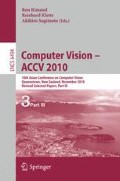Abstract
Many motion segmentation algorithms based on manifold clustering rely on a accurate rank estimation of the trajectory matrix and on a meaningful affinity measure between the estimated manifolds. While it is known that rank estimation is a difficult task, we also point out the problems that can be induced by an affinity measure that neglects the distribution of the principal angles. In this paper we suggest a new interpretation of the rank of the trajectory matrix and a new affinity measure. The rank estimation is performed by analysing which rank leads to a configuration where small and large angles are best separated. The affinity measure is a new function automatically parametrized so that it is able to adapt to the actual configuration of the principal angles. Our technique has one of lowest misclassification rates on the Hopkins155 database and has good performances also on synthetic sequences with up to 5 motions and variable noise level.
Access this chapter
Tax calculation will be finalised at checkout
Purchases are for personal use only
Preview
Unable to display preview. Download preview PDF.
References
Absil, P.A., Edelman, A., Koev, P.: On the largest principal angle between random subspaces. Linear Algebra and its Applications 414, 288–294 (2006)
Björck, A., Golub, G.H.: Numerical methods for computing angles between linear subspaces. Mathematics of Computation 27, 579–594 (1973)
Elhamifar, E., Vidal, R.: Sparse subspace clustering. In: Proc. CVPR, pp. 2790–2797. IEEE, Los Alamitos (2009)
Pinho da Silva, N., Costeira, J.P.: Subspace segmentation with outliers: a grassmannian approach to the maximum consensus subspace. In: Proc. CVPR, pp. 1–6. IEEE, Los Alamitos (2008)
Pinho da Silva, N., Costeira, J.c.P.: The normalized subspace inclusion: Robust clustering of motion subspaces. In: IEEE I. Conf. Comp. Vis., pp. 1444–1450 (2009)
Lauer, F., Schnrr, C.: Spectral clustering of linear subspaces for motion segmentation. In: IEEE I. Conf. Comp. Vis., pp. 678–685 (2009)
Rao, S.R., Tron, R., Vidal, R., Ma, Y.: Motion segmentation via robust subspace separation in the presence of outlying, incomplete, or corrupted trajectories. In: Proc. CVPR, pp. 1–8. IEEE, Los Alamitos (2008)
Tomasi, C., Kanade, T.: Shape and motion from image streams under orthography: a factorization method. Int. J. Comput. Vision 9, 137–154 (1992)
Tron, R., Vidal, R.: A benchmark for the comparison of 3-d motion segmentation algorithms. In: Proc. CVPR, pp. 1–8. IEEE, Los Alamitos (2007)
Vidal, R., Hartley, R.: Motion segmentation with missing data using powerfactorization and gpca. In: Proc. CVPR IEEE, vol. 2, pp. 310–316 (2004)
Yan, J., Pollefeys, M.: A factorization-based approach for articulated nonrigid shape, motion and kinematic chain recovery from video. IEEE Trans. Pattern Anal. Machine Intell. 30, 865–877 (2008)
Zappella, L., Lladö, X., Provenzi, E., Salvi, J.: Enhanced Local Subspace Affinity for Feature-Based Motion Segmentation. Pattern Recognition 44, 454–470 (2011)
Author information
Authors and Affiliations
Editor information
Editors and Affiliations
Rights and permissions
Copyright information
© 2011 Springer-Verlag Berlin Heidelberg
About this paper
Cite this paper
Zappella, L., Provenzi, E., Lladó, X., Salvi, J. (2011). Adaptive Motion Segmentation Algorithm Based on the Principal Angles Configuration. In: Kimmel, R., Klette, R., Sugimoto, A. (eds) Computer Vision – ACCV 2010. ACCV 2010. Lecture Notes in Computer Science, vol 6494. Springer, Berlin, Heidelberg. https://doi.org/10.1007/978-3-642-19318-7_2
Download citation
DOI: https://doi.org/10.1007/978-3-642-19318-7_2
Publisher Name: Springer, Berlin, Heidelberg
Print ISBN: 978-3-642-19317-0
Online ISBN: 978-3-642-19318-7
eBook Packages: Computer ScienceComputer Science (R0)

